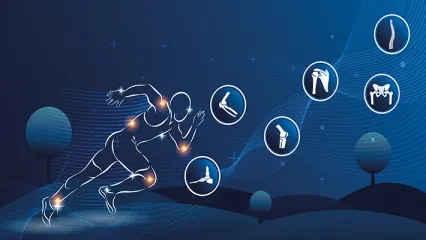Alo Yeditepe
Alo Yeditepe
Robotic Knee Prosthesis Surgery
Especially in recent years, the use of robotic surgery in orthopedic problems has become increasingly common. Robotic surgery technology in knee and hip joint prosthesis surgery allows surgeons to perform surgery more precisely, accurately and in accordance with the patient's anatomy.
Robotic knee prosthesis surgeries, compared to traditional knee prosthesis surgeries; It allows it to heal in a shorter time. Knee prosthesis is used in the treatment of joint injuries that occur due to different reasons such as cartilage wear in the knee, calcification as it is commonly called, traumas and rheumatological diseases.
Regarding the use of robotic surgery in prosthesis surgery: "What is robotic knee prosthesis surgery?", "What are the advantages of robotic knee prosthesis surgery?", "How is robotic knee prosthesis surgery performed?" You can find all your questions, such as, from the rest of the article.
What is Knee Prosthesis?
Knee prosthesis is a surgical procedure performed to restore the functionality of the knee due to damage, pain or loss of function in the knee joint and to enable patients to do their daily work comfortably. Knee prosthesis is performed by replacing the damaged area of the knee joint surface with a smooth metal joint.
Knee replacement may be used to treat the following conditions:
Osteoarthritis: The wear of knee joint cartilage due to advanced age, previous traumas or genetic predisposition is called osteoarthritis. Knee prostheses are frequently used to relieve pain and loss of function caused by cartilage damage in the knee joint.
Post-traumatic injury: If the knee joint is damaged as a result of a serious injury, prosthetic surgery may be required.
Rheumatoid arthritis: Inflammatory joint diseases such as rheumatoid arthritis can cause destruction of the knee joint, and in these cases, knee prosthesis may be considered.
Knee replacement involves a surgical procedure in which artificial components are placed. These components are usually made of metal, ceramic or plastic and restore the functionality of the knee joint. Knee replacement surgery can often improve a person's quality of life and relieve knee pain.
People needing knee replacement surgery should be evaluated by an orthopedic surgeon or specialist and informed about surgical options. In the post-surgical period, physical therapy and rehabilitation can help a person gain better functionality with a knee replacement.
When is Knee Prosthesis Needed?
A knee prosthesis is needed when the damage to a person's knee joint reaches serious levels due to arthritis, trauma or rheumatological diseases. It is possible to list these situations, which can lead to intense pain or loss of function and require prosthetic surgery, as follows:
Knee Prosthesis for the Treatment of Osteoarthritis (arthrolith): As arthritis progresses, which causes the cartilage tissue in the knee joint to deteriorate and wear out over time, it causes complaints such as pain, swelling and joint stiffness to increase. Generally, patients in the older age group are observed; in this case, knee prosthesis is applied to relieve the person's pain and increase mobility.
Traumas and Knee Prosthesis: Falls, accidents or serious injuries can also cause serious damage to the cartilage and bone structure of the knee. In these cases, a knee prosthesis may be required to restore mobility to the person.
Use of Knee Prosthesis in Rheumatoid Arthritis or Other Inflammatory Joint Diseases: Inflammatory joint diseases such as rheumatoid arthritis can cause inflammation, cartilage loss and deformities in the knee joint. In this case, a knee replacement may improve joint functionality.
In addition, deformities that occur in the knee for different reasons can restrict a person's movements and also cause pain. Knee prosthesis may be used to correct or alleviate such deformities.
Knee prosthesis surgery is performed by making a decision together with the patient as a result of a detailed evaluation of the patient by the physician. At this point, the decision is made by evaluating many criteria such as the patient's age, general health condition, complaints and lifestyle. Therefore, patient and physician harmony is very important in achieving successful results.
What is Osteoarthritis?
Knee arthritis, one of the most common joint diseases and medically called osteoarthritis, occurs as a result of the deterioration and wear of the cartilages in the joints. Although it is generally associated with the aging process, it can develop for many reasons that are not limited to age.
As we age, the risk of calcification increases due to the wear and tear of cartilage tissue. Therefore, aging is one of the most important factors. In addition, family history, traumas or joint injuries, intense use of certain joint groups for different reasons,and excess weight, which causes excessive load on the knees and hip joints, are among the factors that increase the risk of arthritis.
What are the symptoms of calcification (Osteoarthritis)?
Symptoms such as knee pain, pain when walking and going up and down stairs, night pain, noise in the knee, and swelling in the knee may be observed in patients with osteoarthritis.
What is Robotic Knee Prosthesis Surgery?
Robotic knee prosthesis surgery allows placing the most suitable prosthesis for the patient's anatomy in the most appropriate way with robot support. In robotic surgery systems, special robotic arms and cameras that help the surgeon control precise movements are used to remove damaged or deteriorated parts of the knee joint and replace them with an artificial knee prosthesis. This surgery offers benefits such as earlier movement and more compatible prosthesis placement compared to traditional methods.
How is Robotic Knee Prosthesis Surgery Performed?
Robotic knee replacement surgery is a procedure that involves the surgeon removing damaged or deteriorated areas of the knee joint with the help of robotic surgical systems and accurately inserting an artificial knee replacement implant. Before robotic knee prosthesis surgery, the process begins with the evaluation of the patient. A detailed examination of the patient is performed and surgery planning is made based on the films. During the postoperative recovery period, the patient may need to start a physical therapy and rehabilitation program. During this period, it is important for the patient to do special exercises to strengthen and heal the joint. Robotic knee replacement surgery is a customized procedure for each patient and may vary depending on factors such as the surgeon's experience, the patient's health condition, and how the surgery will be performed. In the postoperative period, the patient should carefully follow the surgeon's recommendations. This surgery has the potential to restore joint function and relieve pain, but like any surgical intervention, it has risks. For this reason, all possible situations before and after the surgery are explained to the patient in detail by the physician.
Who Can Have Robotic Knee Prosthesis Surgery?
Robotic knee prosthesis surgery is performed in cases where there is severe wear on the knee, such as arthritis, traumas, inflammatory joint diseases, and knee deformities. However, the decision on suitability for robotic knee surgery in these patient groups is determined after the first evaluation with the physician. Since the patient's age, general health condition and lifestyle may also affect the success of the surgery and the recovery process, a personalized approach is also applied in robotic knee surgery. For this reason, people who are considering robotic knee surgery should first consult a physician who specializes in this field and have a comprehensive evaluation.
What are the benefits of Robotic Knee Prosthesis Surgery for the patient?
Compared to traditional surgical methods, robotic knee replacement surgery provides significant benefits for the patient. Among these achievements:
Personalized Treatment Approach: Applying a compatible knee prosthesis to the patient is extremely important in terms of ensuring better adaptation and functionality after surgery. At this point, robotic knee prosthesis surgery can ensure that different parameters such as the patient's anatomy and knee joint dimensions are evaluated with precision and the correct implants are selected and applied. Robotic surgery systems are important in helping the physician. It helps the surgeon plan the incisions and placement of implants more precisely. However, it helps to place implants more accurately and correct joint alignment.
Better Imaging Opportunity: Robotic surgery system provides benefits not only to the patient but also to the surgeon. Since it provides better imaging during surgery, it helps the surgeon make more accurate decisions during the procedure. It is possible to predict the condition of the joint after surgery through robotic planning during surgery.
Faster Recovery: During robotic knee surgery, faster rehabilitation is provided as the prosthesis and patient compatibility is better.
Better Joint Function: Many factors provided by the robotic knee surgery system, such as correct alignment and precise implant placement, affect the joint functions of patients after surgery. Better joint function naturally allows the patient to return to daily activities more quickly and therefore improve the quality of life.
What Should You Pay Attention to After Robotic Knee Prosthesis Surgery?
After robotic knee surgery, as in all other surgical procedures, there are some points that the patient should pay attention to. The most important of these is to pay attention to the doctor's warnings. It is important to comply with the rules regarding physical therapy required for both control appointments and follow-up treatment. After surgery, physical therapy and rehabilitation programs should be started at the time recommended by the physician to increase muscle strength and gain joint mobility. Since smoking and excessive alcohol use can also negatively affect your recovery process, it will be beneficial to limit or quit these habits in accordance with your doctor's recommendations. It is important to attend appointments recommended by your doctor and follow up with regular medical check-ups to monitor your recovery progress and intervene when necessary.
Robotic Knee Surgery Frequently Asked Questions
When Can I Recover After Surgery?
What Should I Pay Attention to in Nutrition After Robotic Knee Surgery?
When Can I Exercise After Robotic Knee Surgery?
Are There Risks of Robotic Knee Prosthesis Surgery?
What is the Cost of Robotic Knee Surgery?
To get detailed information on the subject and to understand the total cost of robotic knee replacement surgery and to find out your health insurance coverage, it would be better to contact a healthcare professional or insurance company.
We would like to remind you that it is important to consider not only the cost but also the surgeon's experience when evaluating your treatment options.
This content was prepared by Yeditepe University Hospitals Medical Editorial Board.
”
See Also
- What are Hip Joint Diseases? Causes and Treatment
- Robotic Hip Replacement Surgery
- Knuckle Cracking Can Be Dangerous When It Becomes a Habit!
- Things to Consider When Walking in Snowy Weather
- What is Hallux Rigidus (Stiff Big Toe/Toe Arthritis)? Symptoms and Treatment
- What is Hallux Valgus (Bunion)? How is it Treated?
- Meniscus and Cartilage Transplantation Can Be Done at the Same Time
- Knee Pain
- Ergonomics in Automobiles Prevents Accidents
- Don't Underestimate Bone Pain That Doesn't Make You Sleep and Doesn't Relieve With Medication
- Joint Pain and Causes of Joint Pain
- Walking and Returning to Social Life After Knee Replacement Surgery
- What Are the Advantages of Robotic Knee Replacement Surgery?
- What Causes Hip Pain? How Does Hip Pain Go Away?
- The Usage Area of Robotic Surgery Expands in Orthopedic Surgeries
- Higher Risk of Anterior Cruciate Ligament and Ankle Injury in Female Athletes
- Patients Who Undergo Joint Replacement Surgery Can Stand Up and Walk the Next Day
- Spinal Fractures
- Big Toes Can Be A Big Problem!
- What is Synovitis in Joints?
- Hip Osteoarthritis and Hip Prosthesis
- Hip Impingement Syndrome
- What is the Future of Treating Cartilage Problems?
- Not Only Athletes Suffer from Meniscus Tears!
- Is Cartilage Damage More Common in Those Who Run for Long Periods?
- Beware If Your Shoulder Or Neck Pain Lasts Longer Than Two Days After Swimming!
- Mistakes While Swimming Can Cause Shoulder Pain
- What is a Stress Fracture? How to Treat Stress Fracture?
- Myths About Fractures
- Vitamin D Deficiency May Be The Cause Of Your Joint Pain
- The First Onset of Pain in Cartilage Damage in the Knee Should Not Be Overlooked
- Have Your Baby Take Their First Steps in Good Health
- Heavy School Bags Can Cause Pain in the Lower Back, Shoulders, and Hands!
- Sports Injuries
- Cartilage Transplantation from Donor Has Been Started to Perform in Turkey
- Working From Home Increases Waist and Neck Problems
- First Cartilage Transplant from a Donor
- Pay Attention to the Pain That Occurs in the Front Part of Your Knees While Playing Sports!
- 8 Common Misconceptions About Sports Injuries
- Young Patient Who Could Not Walk Due to Cartilage Damage Recovered With Cartilage Transplantation
- Knee Arthritis
- Biopsy for Bone and Soft Tissue Tumors
- Knee Pain
- Crunching in the Kneecap May Be a Sign of Calcification
- Injured Athletes Can Return To Sports With Cartilage Transplant
- Treatment of Knee Arthrosis Varies According to the Person
- A Lack of Attention to Sports Injuries in Children May Affect Their Development
Alo Yeditepe




